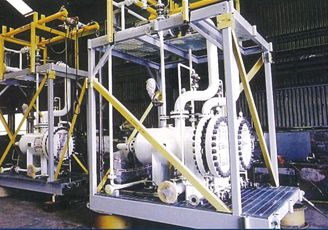Hydrocyclone - Deoiling & Desanding
OVERVIEW
ETS Deoiling Hydro-Cyclones balance oil removal efficiency and overall capacity to ensure that separation requirements are met in the most cost effective and space saving way. The liners have been designed so that the Hydro-Cyclone is ultra-slim with a high number of liners to accomodate a given vessel size.

 LINEAR DESIGN – DEOILING
LINEAR DESIGN – DEOILING
Our Deoiling Hydrocyclone liners are most commonly manufactured in Duplex Stainless Steel with surface hardening on the internal surfaces exposed to high fluid velocities to ensure long life in erosive systems. For extreme erosive applications, ETS offers liners manufactured from Stellite 6, Tungsten Carbide or Reaction Bonded Silicon Carbide, an advanced ceramic which will provide a wear life of up to 10 times that of a standard Duplex liner.
 CAPABILITIES
CAPABILITIES
- New-Build and Retro-fit Systems which can range from fully automated packaged systems with and without produced water de-gassing vessels and IGF systems to stand alone vessels or simply the Hydrocyclone liners and internal support plates. Standard pressure vessel designs are available at design pressures up to 1500# ANSI equivalent. Higher pressures are feasible on request.
- Spare Liners. The ETS range of liners can be adapted to fit into most third party vessels without the requirement for any modification to the existing vessel.
- Capacity and Efficiency Upgrades. Existing vessel capacity can be increased by up to 80% while improving separation performance by up to 30%. This can be done without the addition of extra Hydrocyclone vessels or modification to existing pipework. The ETS B-20 liner can be adapted to retro-fit all existing types of Hydrocyclone vessels.
- Rental Systems. We have a range of packaged pilot systems for rental up to a capacity of 25,000 BPD (165 m3/h).
HIGH TURNDOWN VESSEL DESIGN
For applications requiring very high turndown, ETS offers its HTD compartmentalised vessel approach. Internal baffles are used to divide the vessel into either two or three compartments. Each compartment can be switched in or out of service using external valving, effectively providing a number of smaller vessels within a single vessel housing. This operation can be automated. The ETS HTD design has considerable benefits over traditional methods to increase turndown as it removes the need for either blanking liners or multiple vessels. In a typical installation, the ETS HTD design can increase turndown from 3:1 to 10:1 for a two compartment and over 50:1 for a three compartment HTD vessel.
LINEAR DESIGN – DESANDING

The MC Series Desanding hydrocyclone geometries have been developed in house, undergoing rigorous testing both in the lab and in the field and are now widely used globally. Desanding Hydrocyclone separation efficiency and capacity is a strong function of hydrocyclone diameter. The smaller the diameter, the smaller the particles that can be separated but the lower the capacity of each hydrocyclone. ETS offers four sizes within the MC Series range to ensure that an optimised solution can be offered for the diverse range of solids management applications encountered.
In the MC Series configuration, large numbers of small diameter Desanding Hydrocyclones are installed in a single vessel to achieve high sand removal efficiencies at high flowrates. In all cases, the liner packing is highly efficient which allows ETS to offer highly compact vessel designs. ETS manufactures the MC series hydrocyclone liners from engineering grade alumina ceramics as standard but for highly erosive applications, Reaction Bonded Silicon Carbide, an extremely hard wearing advanced ceramic, is used, providing typically 6 times the wear life of an alumina ceramic equivalent.


